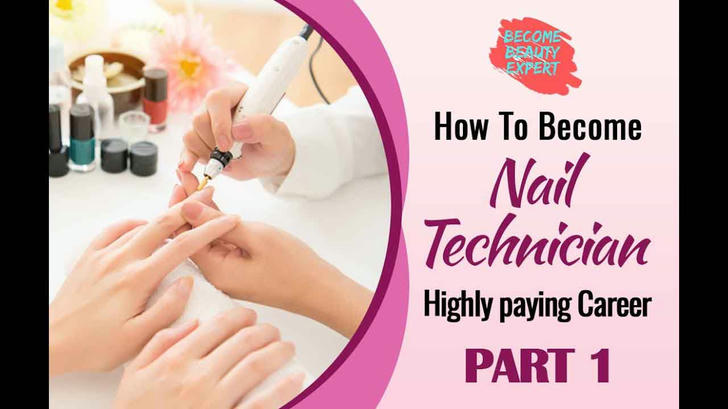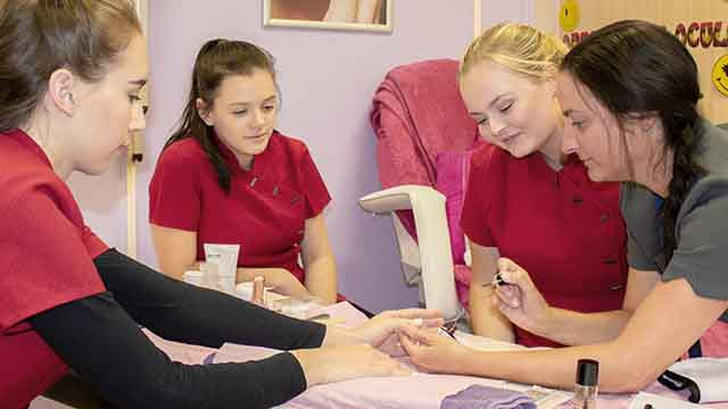Launching Your Career as a Nail Technician:Paid training,no experience required,good benefits
In the U.S., nail techs can earn good money-up to $100 a day-after just 1–4 months of paid, certified training; with over 110,000 jobs available, it’s a fast, helping beginners quickly enter the field, where job prospects are especially strong in urban areas.

Why Choose a Career as a Nail Technician?
Nail care is considered a popular low-cost luxury service that appeals to a wide range of clients. People increasingly seek manicures, pedicures, nail art, and specialized treatments to look and feel their best. The U.S. Bureau of Labor Statistics projects a 10% job growth for manicurists and pedicurists over the next decade, which is twice as fast as the average for all occupations. This growth is fueled by trends such as mobile nail services, non-toxic and organic nail care, and creative nail art shared widely on platforms like Instagram and YouTube.
Benefits and salaries in the nail industry
In the United States, nail technicians (manicurists and pedicurists) earn an average hourly wage of about $13.17, with an annual salary around $27,390. Experienced technicians can make $90 to $100 or more per day, especially in major cities like New York where tips and demand are higher. However, working conditions and benefits in the nail industry vary widely. Entry-level workers often undergo unpaid or low-paid apprenticeships lasting several months, and some areas face challenges such as low wages, long hours, and limited labor protections.
Step-by-Step Guide to Applying for a Government-Funded Nail Technician Course
1. Check Your Eligibility
Most government-funded nail technician courses have basic requirements:
Be at least 16 or 18 years old (depending on the state).
Have a high school diploma or GED equivalent.
Be legally allowed to work in the U.S.
Some programs require you to be unemployed or hold certain benefit cards, such as a health care card or pension concession card, especially in states like Washington or programs in Australia that may have similar funding models.
2. Research Available Courses Near You
Look for state-approved or accredited nail technician programs. These programs meet the requirements for state licensure and provide quality training. You can find courses at community colleges, beauty academies, or specialized training centers. For example:
Connecticut State offers nail technician courses that prepare you for the state license.
Arizona Academy of Beauty provides a 600-hour program with financial aid options.
San Diego City College offers a one-semester nail technician program with licensing preparation.
Use online course finders or contact your local workforce center to find government-funded options in your area.
In the U.S., government-supported paid nail technician training programs are primarily offered through community colleges, technical schools, and workforce development centers that provide state-approved nail technology courses combined with financial aid or scholarships.
How to Find Federal and State Financial Aid Opportunities:
Check State Workforce Development Boards and Community Colleges:
Visit your state’s workforce development website or local community colleges to find nail technician programs eligible for financial aid or WIOA funding.
Apply for Financial Aid:
Fill out the Federal Application for Student Aid (FAFSA) to determine if you are eligible for federal grants and loans to cover your tuition.
Contact Cosmetology Licensing Boards:
Inquire about state-approved apprenticeship programs or trainee licenses that allow you to work and train simultaneously under supervision.
Explore Scholarships and Grants:
Many beauty schools and workforce programs offer scholarships or grants specifically for cosmetology and nail technology students.
Reach Out to Local Salons:
Some salons offer paid apprenticeships or on-the-job training; these may not be government-funded but provide income while gaining experience.
Johnson County Community College (JCCC) offers a comprehensive Nail Technology program that prepares students for licensure in as little as 13 weeks, combining classroom instruction and salon clinic experience. While not explicitly labeled as “paid apprenticeships,” such programs often qualify for federal financial aid (FAFSA) or state workforce grants that can cover tuition costs.
Montgomery College in Maryland provides a 250-hour Nail Technician program approved by the Maryland Board of Cosmetologists. Students receive the necessary training to sit for licensing exams, and financial aid options may be available to reduce out-of-pocket expenses.
Austin Kade Academy in Idaho offers a 600-hour Nail Technology program approved by the Workforce Innovation and Opportunity Act (WIOA), which supports eligible students with funding for tuition and training costs. This program includes both practical nail care skills and business training to prepare students for successful careers. Financial aid options such as FAFSA and scholarships are accessible, effectively making the training low-cost or paid for qualifying individuals.
Technical College of the Rockies (Colorado) offers an 18-week, 611-hour Nail Technician program meeting state licensing requirements. While tuition is required, students can often apply for federal or state financial aid to offset costs.

Join a Paid Apprenticeship Program – Earn While You Learn
1. Heather’s Nail Boutique Paid Apprenticeship (Washington State)
Heather’s Nail Boutique offers a select paid apprenticeship program where you can gain all the training hours and skills needed to obtain your license. Apprentices earn income while working full-time in the salon and receive personalized training. However, the program requires candidates to commit to joining the team long-term and must pass an interview. Apprentices will sign a 3-year training expense reimbursement agreement that reflects the salon’s investment.
How to Apply: Visit the Heather’s Nail Boutique website, submit an application, and complete an interview process when a position becomes available.
2. Topcoat Nail Bar Apprenticeship Programs (Utah)
Topcoat Nail Bar provides two apprenticeship tracks: a Core Nail Tech Apprenticeship and a Master Nail Tech Apprenticeship. These programs offer extensive real salon experience (up to 2000 hours), business coaching, and training in advanced nail techniques. Apprentices start earning wages and tips after completing a portion of their hours. There are no educational prerequisites, but apprentices must register with the state.
How to apply: Contact Topcoat Nail Bar directly via their website for enrollment details and guidance on state registration.
3. Polished Looks Nail Salon Apprenticeship (Utah)
This part-time program requires 375 training hours over about 16 weeks. Apprentices receive hands-on salon experience, compensation for services performed, and business education. Tuition is around $9,500, including a professional kit. Apprentices build clientele during training and get job assistance upon graduation.
How to apply: Reach out to Polished Looks Nail Salon through their website or contact their instructors to inquire about enrollment and payment plans.
4. State-Registered Apprenticeship Programs
Some states, like Maryland and California, offer official apprenticeship licenses allowing candidates to train under licensed cosmetologists or nail technicians while earning wages. For example, Maryland’s Apprentice Limited Nail Technician License requires sponsorship by a licensed professional and completion of training hours (e.g., 8 months at 20 hours/week). California’s Board of Barbering and Cosmetology oversees apprenticeships that combine on-the-job training (minimum 3200 hours over 2 years) with classroom instruction.
How to apply:
Contact your state’s cosmetology board or licensing department for apprenticeship requirements and approved sponsors.
Complete the necessary application forms, including sponsorship agreements.
Attend orientation sessions as required by the state board.
From Student to Certified Nail Technician: Inspiring Success Stories
Tatyana Tkachenko: Balancing Family Life and Pursuing Passion
Tatyana Tkachenko, a former stay-at-home mom, decided to pursue her passion for nails by enrolling in a reputable nail program at Evergreen Beauty College. She found joy in transforming clients' nails and seeing them leave with a smile. The program's comprehensive curriculum, which included both theory and hands-on practice, helped Tatyana develop strong design skills and a deep understanding of nail health. While in school, she focused on providing quality service over quantity and building her clientele through social media. Tatyana's advice to new students is simple: "Practice makes perfect". After graduation, she plans to continue building her clientele while working independently, with the long-term goal of opening her own nail salon.
Chloe: Gold Medalist and Skills Champion
Chloe's story begins with overcoming bullying in school and discovering her passion for nails through her nail technician, Sarah Thompson. Encouraged by Sarah and her tutor Kelly Barton at Riverside College, Chloe entered the WorldSkills UK competition. Despite facing anxiety and losing a client just weeks before the competition, Chloe persevered and won a Gold Medal in Nail Technician/Beauty Therapy at the National Finals in 2018. This achievement led her to become a Skills Champion, where she inspires young people to pursue vocational careers. Chloe credits the competition for developing her technical skills, time management, resilience, and confidence, leading to numerous job offers. Now, Chloe is studying to become a tutor, aiming to share her expertise with future generations.

Career Paths After Certification
Graduating as a nail technician opens multiple career opportunities:
Salon or Spa Technician: Working in salons, spas, or resorts providing manicures, pedicures, and nail enhancements.
Mobile Nail Technician: Traveling to clients’ homes or events, offering convenience and personalized service.
Nail Artist: Specializing in creative and intricate nail art, often building a social media following.
Nail Instructor: Teaching new students in beauty schools or training centers.
Salon Owner or Entrepreneur: Starting your own nail salon or beauty business.
Product Manager or Consultant: Working with nail care brands to develop or market products.
Some nail technicians also become influencers, showcasing their work on Instagram or YouTube, collaborating with brands, and attending fashion events.
What to Look for When Choosing a Nail Technician Program
Accreditation: Ensure the program is recognized by your state’s licensing board.
Comprehensive Curriculum: Covers all essential skills, sanitation, and business practices.
Hands-On Training: Practice on live models or in student salons.
Experienced Instructors: Learn from qualified professionals.
Flexible Scheduling: Options for full-time, part-time, or online learning.
Career Support: Assistance with licensing exam prep and job placement.
Cost and Financial Aid: Compare tuition and check for scholarships or government funding.
Becoming a nail technician in the U.S. is an achievable and promising career choice. With growing demand, creative opportunities, and flexible work options, it offers a path to financial independence and personal fulfillment. Start by enrolling in an accredited nail technician program, gain your certification, and explore the many career paths available. Whether you dream of working in a salon, freelancing, teaching, or owning a business, the nail industry has room for your talents and ambitions.
